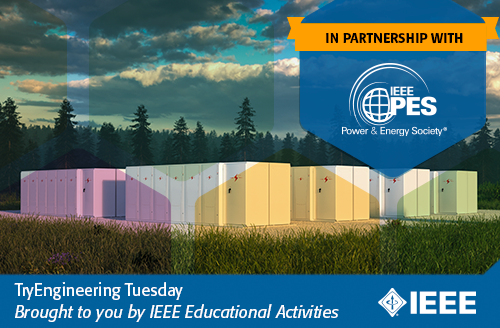Energy Storage TryEngineering Tuesday

This month’s topic is going to be all about the importance of Energy Storage. Energy has been and will continue to be a driving force in not only engineering but across humanity, as much of our economic, political, and societal structures are so heavily influenced by this topic. While we have recognized many sources of generating energy available to us, storing and delivering energy in a cost-effective and efficient way can be quite challenging, especially when it comes to renewable sources. Engineers are always thinking about how to solve the world’s problems, so join us as we learn about energy storage and how it influences the world we live in.

Energy storage goes far beyond the basic concept of batteries. Sure batteries are a safe and convenient option to store energy for smaller and localized needs, such as TV remotes and hand-held devices, but they would not be a realistic source of power to heat large commercial buildings or power a metropolitan area. There are many well-known sources of energy to address these larger needs, such as fossil fuels, nuclear power, sun, and wind. But have you ever really thought about the process of how we harness, store, and deliver energy in a way that meets the needs of billions of people essentially on demand? If you have ever flipped a light switch off and on, you can thank an engineer for finding a way to store and deliver that energy to you exactly when you needed it (and stopped the delivery when you didn’t). The following exploration tools will help you understand the various resources for energy available to us, what our current methods for storing energy are, and what challenges engineers face in providing safe, renewable, and cost-effective energy to the world.
- Join us for an interview with Dr. Babak Enayati, Manager, Distributed Generation Standards and New Technology Team, National Grid, for the TryEngineering Tuesday Webinar on Energy Storage to learn more about the topic.
- Just what is energy storage? Watch this video from Student Energy for a quick lesson on Energy Storage 101.
- What are the options for storing energy relative to the needs of society? Learn more in this article from ARS Technica.

- What is the power grid and why is it critical to energy collection, storage, and consumption? Watch these videos from Practical Engineering on How the Power Grid Works and Pumped Storage.
- Learn how many companies are seeking to leverage gravity as a way to produce and store energy in this IEEE Spectrum article.
- Danielle Fong is passionate about finding a solution to energy sustainability. Learm more about her ideas on energy storage in this YouTube video of her TEDx Talk.
Image Source: ARS Technica

Have fun and learn more about Energy Storage by trying out some hands-on activities.
- In this lesson on Solar Power from IEEE TryEngineering.org, students can learn how to take solar panels beyond their current limitations of only being able to provide direct current power during the day and effectively store solar energy for use in an on-demand
 environment.
environment. - Simulate the role of managing a power plant and preventing a black out in this game from next-kraftwerke.com.
- This lesson from Cyber Resiliant Energy Delivery Consortium (CREDC) is designed to allow students (and others) to explore power and energy usage in the home
- Another lesson from Cyber Resiliant Energy Delivery Consortium (CREDC) provides the experience to observe the effects when changes occur throughout an entire power grid system, from multiple energy sources, substations, consumers, and external systems.
Image Source: next-kraftwerke.com

Be inspired by hearing how your peers are making a difference in their communities and then try it yourself!
- Studentenergy.org is a post-secondary global organization empowering the next generation of leaders who are accelerating the
 transition to a sustainable, equitable energy future.
transition to a sustainable, equitable energy future. - Solar Spring Break is a unique opportunity for MIT students to make a positive difference while exploring their passion for clean energy. Read more about it here in this article from MIT Energy Initiative.
- In this video from the University of Houston, students demonstrate their project to provide energy efficient and affordable homes in their community.
Have a different idea on how to make a positive difference in your community? Be creative! Then share with the TryEngineering family to inspire others to do the same.
Image Source: MIT Energy Initiative

- Write down at least one new thing that you learned about Energy Storage.
- Think about how to inspire others and make a difference in your community.

- Have you, a family member, or teacher share your work on Facebook or Twitter using #tryengineeringtuesday. We want to hear from you!
- If you tried any of the activities, make sure you download your IEEE Power & Energy Society Badge. Collect them all and store them using this Badge collection tool.
Thank you to the IEEE Power & Energy Society for making this TryEngineering Tuesday possible!
























